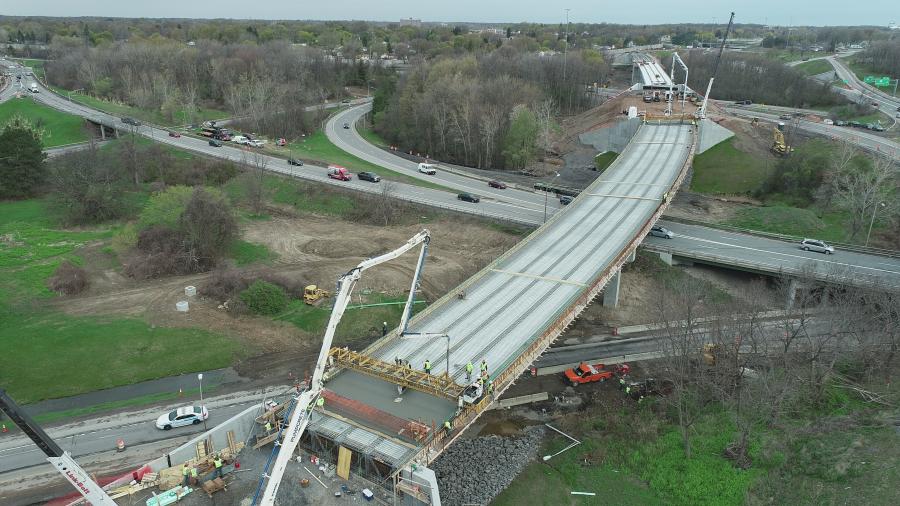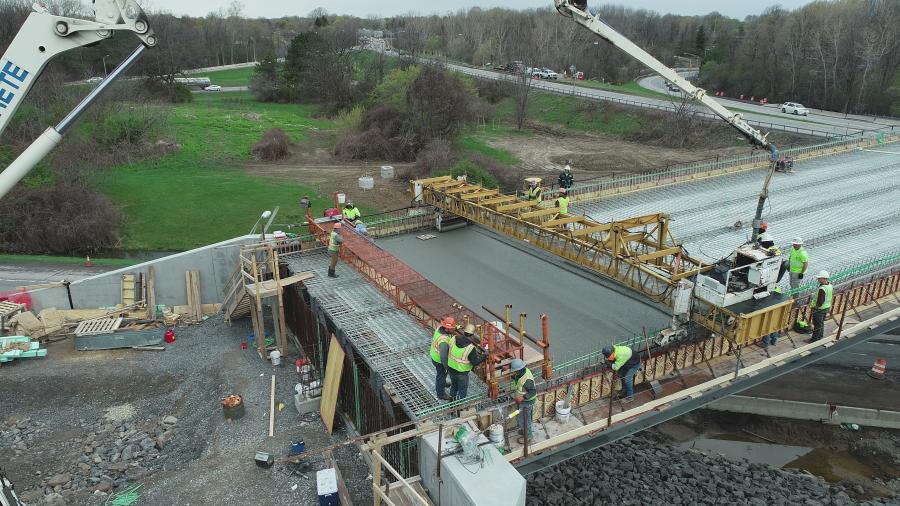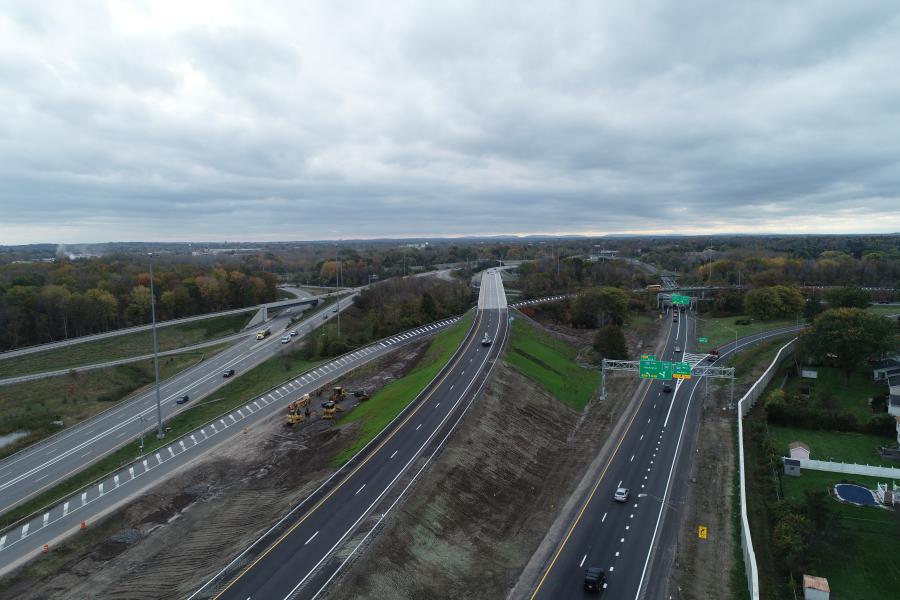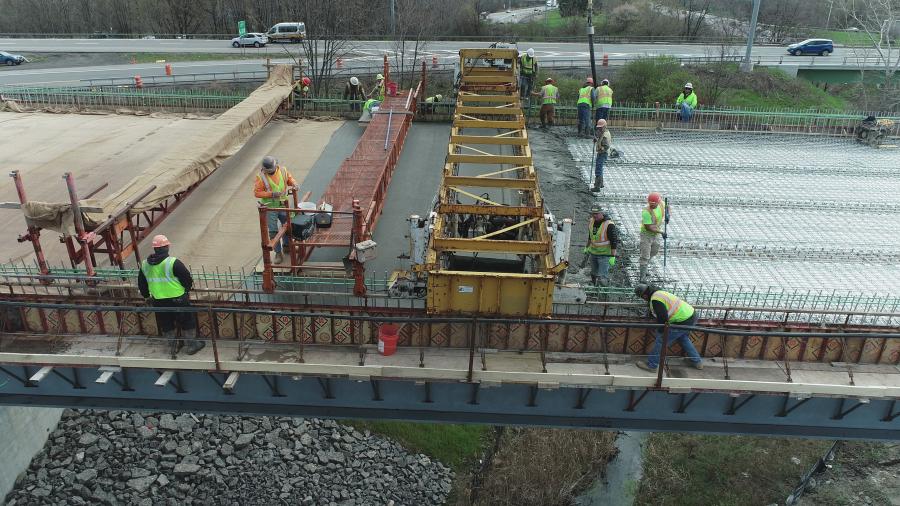Cold Spring Construction Co. (CSC) competed the work in four phases, which had crews working at multiple sites.
(Photo courtesy of New York State Department of Transportation.)
The New York State Department of Transportation's (NYSDOT) $172.8 million design-build I-390/I-490 Interchange Improvement Project was recognized by the American Public Works Association for Transportation Projects Greater than $75 million for its many positive impacts.
Cold Spring Construction Co. (CSC) competed the work in four phases, which had crews working at multiple sites.
Key aspects of this multi-phase project included the replacement of the Lyell Avenue Bridge and the Trolley Boulevard Bridges over Interstate 390; realignment of the Lyell Road and Lee Road intersection; construction of new southbound flyover lanes at the interchange south of the Lyell Avenue bridge; and the construction of fourth travel lane on Interstate 390 south between Interstate 490 and Chili Avenue.
"In addition to supporting nearly 200,000 daily motorists, the project provides enhanced access to centers of economic activity, including the Greater Rochester International Airport, the Rochester Technology Park, the Eastman Business Park and downtown Rochester," according to NYSDOT. "The improvements are central to the advancing the regional and global competitiveness of the City of Rochester and the greater Finger Lakes Region. The project, delivered in three-phases was completed on budget and ahead of schedule."
Financed by state and federal funds, the project is part of NYSDOT's "Finger Lakes Forward" initiative, the region's "comprehensive blueprint to generate robust economic growth and community development. The state has already invested more than $8.07 billion in the region since 2012 to lay the groundwork for the plan — investing in key industries including photonics, agriculture and food production and advanced manufacturing. Now, the region is accelerating Finger Lakes Forward with a $500 million state investment through the Upstate Revitalization Initiative. The state's $500 million investment will incentivize private business to invest well over $2.5 billion — and the region's plan, as submitted, projects up to 8,200 new jobs."
The new infrastructures were designed by NYSDOT & Erdman Anthony, which divided the project into four phases: the Lyell Ave. Bridge over I-490, the second and third that covered a section of Lyall Ave. and the northbound I-390 and I-490 interchange, and the fourth, the section of Lyell Ave. and the southbound interchange.
"There were some engineering challenges in building fills in some of the areas," said Len Davison, NYSDOT's engineer-in-charge for the project. "We resolved this issue by extending some of the superstructures. On every aspect of the job there were challenges, which included the construction of the noise wall. We worked through them all together — Cold Spring a very good contractor."
The new bridges were designed to have a lifespan of 75 years, the sound walls will stand for more than 100 years, and the asphalt overlay of the concrete lanes — 2 in. of binder and 1 in. of asphalt — should last for 12 years
"We used a new mix of concrete — HPIC, which has an internal curing aspect to it where we flood the aggregate and release the water which accelerates the curing process and keeps the concrete cool during the curing stage."
Traffic was a major challenge during the construction.
"Getting material to where it was needed posed many challenges," said Davison. "During COVID, the supply of materials was also a problem, but everything was completed on schedule. Solutions were found and nothing was delayed.
Work sites were tight on many occasions, and the northbound and southbound Canal bridges required more work than expected.
"The existing steel was the challenge," said Davison. "It was in worse condition that what we expected. Cold Spring had to replace a few steel girders."
Crews worked six days a week, putting in 10-hours shifts, as well as numerous night shifts.
Utility relocation was required on numerous occasions.
"There was a major electrical crossing and major challenges designing the noise wall to deal with all the underground infrastructures," said Davison. "Some of the utilities were relocated. There were also water lines, high pressure gas lines, and a high-tension oil encased main down there. Some of them could not be moved and we designed the foundations of the sound walls around them. Coordination was essential for this aspect the utilities cooperated with us.
"Cold Spring has a partnering mindset and they were a pleasure to work with," he added, noting the general contractor's project manager was Jeff Younger.
Bridge replacement and construction was key element of the project. The Lyell Ave, bridge and Trolley Blvd. bridges over I-390 were replaced and widened. One of the flyovers led to the construction of three new bridges, and new bridge was built for Buffalo Road over I-390. I-390, northbound and southbound, consist of multiple lanes in each direction with shoulders on both sides.
For the Trolley Blvd. bridges, a precast concrete bridge was put in place over the existing ones.
"Once it was put in place and filled over, we were able to remove the old bridge," said Davison. "It really worked out well and traffic was undisturbed during the construction process. It was more of a retrofit for the Canal bridges, which included replacing some girders. This aspect was a full deck replacement. It was a three-sided arch, so we built footers and then used a forklift to set the precast arch pieces because we had existing bridges over us. We set the precast arches were then able to fill up the area to a certain point."
Bridge demolition was done at night, which required road closures beneath them and managing the traffic above them. The debris was removed rapidly as the roads below were re-opened to traffic in the morning
The smaller bridges took three days to demolish, while the longer ones took about five days on average.
The new bridges (the smaller ones) could be constructed in roughly 120 days and the larger ones between 180 and 200 days.
"Once you set the steel, you're pretty much working on the whole deck," said Davison. "You tie the rebar from one end to the other and you do the same with the concrete pour."
The bridge work required a serious amount of equipment, including excavators, dozers, bridge finishing machines, various drills, crawler and rubber-tire cranes.
"Anything you can imagine was used on this project," said Davison.
Due to the tight work zones, materials were brought in on an "as needed" basis.
Cold Spring set up a concrete batch plant to ensure that concrete was produced when needed and could be brought to the various sits rapidly.
It was located in their yard and that made things a little easier," said Davison. "They did a lot of pouring at night and there were a lot of night shifts for this aspect."
The realignment of the Lyell Road and Lee Road intersection; was done after the bridge was construction.
"The new ramp alignment was built out of traffic, which facilitated the effort," said Davison. "The main challenge was working with the gas distribution companies because we had to reconfigure the lines and the impacts on the businesses in the area. However, it was only short time that we disturbed Lyell Ave. It was just a tie-in. This work had to be done, but the impacts were minimal.
The construction of new southbound flyover lanes at the interchange south of the Lyell Avenue bridge had crews install three structures.
"Two were identical," said Davison. "One challenge was designing bridges that spanned he fill area without a joint.. They designed a tower abutment so we could put the joints above the tower instead of over the bearings."
"A lot of the bridge work was crane work," said Davison, "and hands on carpentry and iron workers."
The construction of fourth travel lane on I-390 south between I-490 and Chili Ave., one in each direction, took about two years to complete. This was done when the flyovers were constructed
"We were able to do lane closures and some work at night where we totally shut down I-390," said Davison. "Then we had to do all the tie-ins, which was completed after the flyovers were open to traffic."
The new lanes were asphalt ones with a subbase, base, binder and asphalt toping. Crews took on one side and then transferred their equipment to the other side. Cold Spring, for this operation, had excavation, prep, and paving crews working simultaneously.
Crews excavated and demolished a fair amount of concrete, steel and asphalt
"A lot of the concrete was crushed on site and re-used as subbase and stone fill," said Davison. "The steel was brought to a recycling center. NYSDOT maximizes efforts to recycle and on this job more than 50 percent of the materials were recycled."
New materials included large amounts of concrete, steel beams and rebar, and asphalt.
On peak days Cold Spring had between 70 and 80 people and the subcontractors — local and regional — added another 30 people, with usually four or five on site.
Cold Spring had an onsite mechanic, along with an assistant.
"Often times, they would hire out for other repair work and electrical stuff," said Davison. "If a vehicle broke down, they could fix it rapidly. Staying on schedule was crucial."
Looking back at the project, Davison pointed out that "nothing really goes as planned, but this project met my expectations, which were pretty high."
The project allowed NYSDOT to train new staff and give current staff an opportunity to experience working on a larger project.
"We have a very good staff," said Davison. "If you get new people when they are young, they have an opportunity to learn the ropes." CEG
Irwin Rapoport
A journalist who started his career at a weekly community newspaper, Irwin Rapoport has written about construction and architecture for more than 15 years, as well as a variety of other subjects, such as recycling, environmental issues, business supply chains, property development, pulp and paper, agriculture, solar power and energy, and education. Getting the story right and illustrating the hard work and professionalism that goes into completing road, bridge, and building projects is important to him. A key element of his construction articles is to provide readers with an opportunity to see how general contractors and departments of transportation complete their projects and address challenges so that lessons learned can be shared with a wider audience.
Rapoport has a BA in History and a Minor in Political Science from Concordia University. His hobbies include hiking, birding, cycling, reading, going to concerts and plays, hanging out with friends and family, and architecture. He is keen to one day write an MA thesis on military and economic planning by the Great Powers prior to the start of the First World War.
Read more from Irwin Rapoport here.
Today's top stories

















